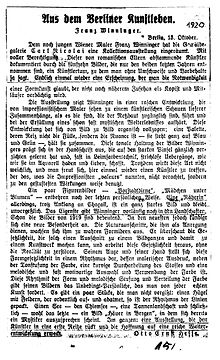Franz Winninger
Franz Winninger (born October 4, 1893 in Vienna , † April 4, 1960 in Berlin ) was an Austrian landscape and portrait painter .
Life

Winninger studied at the School of Applied Arts in Vienna with Franz Čižek . After completing his studies, he began to travel through Austria up to Dalmatia. Winninger stayed in monasteries and paid for board and lodging by restoring panel paintings and frescoes. He also had a wonderful natural voice. As a singer of folk songs and as a yodeler, he earned a living in towns and villages where he intended to paint. That's how he came to Paris. In a Monmartre bar, Henri Matisse discovered the young artist who was singing and drawing between performances and took him into his studio.
From there he went to Munich-Dachau, where he lived and worked among the local artists from Brettle-Gesang. Recommendations brought him to Frankfurt am Main from 1912/1913 to 1915. Through the actress Grete Kaiser and her friends Heinrich George and Oskar Ebelsbacher, he found his way into artistically open-minded circles and was accepted in the studio of the painter and collector Gustav Deubel. The photo of Franz Winninger with a guitar comes from his daughter. The physician Paul Ehrlich bought two paintings and paved the way to his Berlin friend Alfred Blaschko . Winninger became a member of the Berlin Secession under Max Liebermann . The portrait of Friedel Wittkowski (1916?), A niece of Max Liebermann, made Winninger famous overnight. Various exhibitions followed, first with Axel Junker on Kurfürstendamm, in the Free Secession, with Friedmann & Weber and in 1920 in the Carl Nicolai Gallery (all Berlin), which Otto Ernst Hesse reviewed. Carl Nicolai represented Winninger as an art dealer. Its register of sales was lost in World War II. Various collectors buy pictures from him. In 1918 he married Maria Haase.
In the mid-twenties he traveled to Abyssinia on behalf of the Hermannsburg Mission to see what was then Ras Tafari, the later Negus and Emperor Haile Selassie . In 1927 he settled in Addis Ababa . In 1928 he separated from his wife Maria Haase.
During the Second World War Winninger had to leave Germany and spent the years in England. After the war he returned and settled in Berlin. Nothing is known of any exhibitions between 1933 and his death in 1960. In 1965 there was an exhibition with lithographs and drawings in the Graphisches Kabinett Karl Vonderbank in Frankfurt am Main, followed by a second exhibition with paintings in the Heusenstamm Foundation in Frankfurt in 1966.
Artistic development
Winninger started drawing at the age of seven. Since his family lived very poorly, he exchanged his drawings at bakers and wherever for Heller in order to be able to buy material.
The Viennese art historian and critic Arthur Rössler discovered his early talent and led him to the painter Franz Čižek at the Vienna School of Applied Arts. This is where the foundations for his nature-oriented work were laid. The meeting with Henri Matisse in Paris expanded his color palette. The colors of the watercolors from the trips to Africa also reveal this.
Many drawings of bridges were made in Berlin. The quick capture of groups and portrait drawings were his strengths. In Berlin coffeehouses and taverns, he drew people with quick, sketchy lines on small postcard-sized sheets of paper. Most of these works are not dated. In 1920 the lithographs for the portfolio Irre Menschen (1921) were created, which are still strongly determined by an expressionist formal language, while the portrait of the writer Hans Schiebelhuth (1895–1944) can be assigned to the New Objectivity.
literature
- Franz Winninger: painter's journey through Abyssinia . Freiheitsverlag, Berlin 1937, DNB 578381915 (195 p., Color cover picture, 12 art print panels , 12 drawings in the text, 1 terrain map).
- Winninger, Franz . In: Hans Vollmer (Hrsg.): General lexicon of fine artists from antiquity to the present . Founded by Ulrich Thieme and Felix Becker . tape 36 : Wilhelmy-Zyzywi . EA Seemann, Leipzig 1947, p. 70 .
- Winninger, Franz . In: Hans Vollmer (Hrsg.): General Lexicon of Fine Artists of the XX. Century. tape 5 : V-Z. Supplements: A-G . EA Seemann, Leipzig 1961, p. 147 .
- Winninger, Franz. In: Heinrich Fuchs: The Austrian painters born in 1881–1900. Volume 2. Vienna 1977, DNB 578381915 .
Individual evidence
- ^ Franz Winninger: painter's journey through Abyssinia. Safari Verlag, Berlin 1928.
- ↑ Bairu Tafla: Ethiopia and Austria: A History of Their Relations. Otto Harrassowitz Verlag, 1994, chap. 7, p. 294.
| personal data | |
|---|---|
| SURNAME | Winninger, Franz |
| BRIEF DESCRIPTION | Austrian landscape and portrait painter |
| DATE OF BIRTH | October 4, 1893 |
| PLACE OF BIRTH | Vienna |
| DATE OF DEATH | April 4th 1960 |
| Place of death | Berlin |